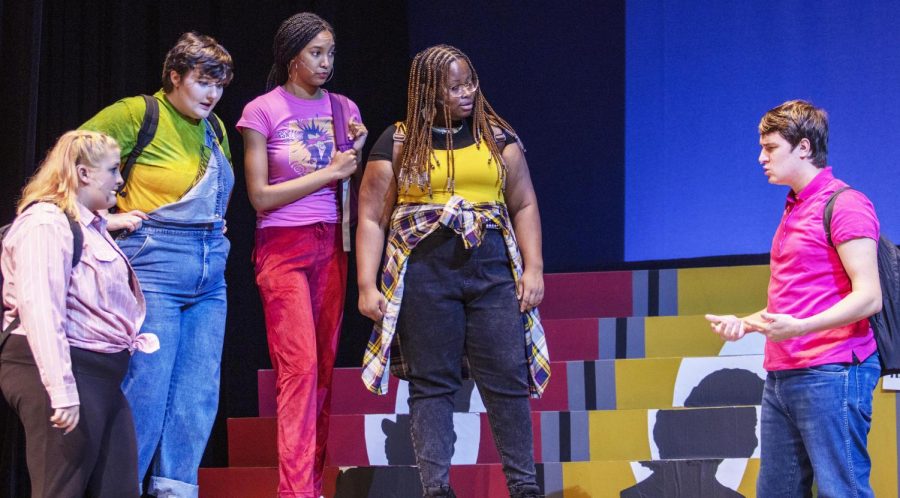‘Blood at the Root’ examines racism, social justice
In the play “Blood at the Root” at Doudna Fine Arts Center Theatre, immediately after a fight breaks out, everyone is gossips about who started it, what happened, and why.
November 14, 2021
‘Blood At The Root,’ a play by playwright Dominique Morisseau, debuted in the Doudna Fine Arts Center’s Theatre Thursday, Nov. 11, with it wrapping on Sunday.
The play fictionalized events that took place in Jena, La. in 2006. Guest director, Janai Lashon, wants viewers to remember that the play is based on true events.
“We have to remember that this is not just a fictional show,” said Lashon. “This show is based off true historic events that took place in America.”
While the events took place over ten years ago, Lashon said she hopes that the audience realizes that ending racism does not have a simple solution and that “the work is so far from being done.”
“There is no cookie cutter arrival of ‘We did it. It’s over. It’s done,’” said Lashon. “The playwright chooses to put an interesting image on stage at the end. I really hope that it’s unsettling. I hope that they really hear the poetry of the story. I hope that it provokes questions and conversation around racism, around present day versus over ten years ago and the impact it has on youth.”
Chuck Westendorf, a sophomore digital media technology major, played Colin in the play. Westendorf thinks that the play shows how important it is to listen to other people’s experiences.
Westendorf said he hopes the play teaches people to not be racist or homophobic.
“Don’t be racist or homophobic. Honestly, that’s the biggest takeaway,” Westendorf said. “Hate’s kind of bad. Open yourself to others’ experiences. [The play] was really showing black culture, what they go through and different perspectives that a lot of people don’t see.”
Rashad Oliver, a junior digital media technology major, attended the performance. They said they think that this play was good to put on.
“I think the people out there did a really good job,” Oliver said. “I think the message is very important to have because there’s a lot of like interracial conflicts that could happen on campus, so I think it was a really good play to put on.”
The set of ‘Blood on The Root’ included a tree, a bench, some bleachers, a table, two chairs and blocks that the actors could sit on. The blocks were red and yellow and had the names Uncle Sam, Davis, Roosevelt, Bridges, Kennedy, Flo Jo and Parks.
Some of these figures were important in Black history and the civil rights movement.
Lashon thinks that there is a message of breaking rules in this play.
“Break rules by any means necessary,” said Lashon. “Racism is not an exception to you standing up for yourself, making your voice be heard. Any time is a time for change when we’re talking about fighting injustice. I think ‘Blood At the Root’ is a mirror reflection.”
During the play, the protagonist, named Raylynn, sits under a tree that normally only white students sat under. This causes outrage among the student body.
Brea Howard, a freshman theater major, played Raylynn. Howard thought the importance of this message is bigger than the stage.
“The message for me has always been about the corruption of our legal system,” said Howard. “I just hope that the audience members realize how big of an issue it is and how even though this play was set in 2006, this is a story that could take place tomorrow. It’s so important that we see and understand how significant that is.”
While Oliver thought the message was similar, they thought that the play had a different twist.
“One, things are a lot deeper than they may seem at first glance,” said Oliver. “Two, things are working better if you try to put yourself in other people’s shoes.”
Katja Benz can be reached at 581-2812 or [email protected].




















































